Volume Two
Modern States
Colonial Empires
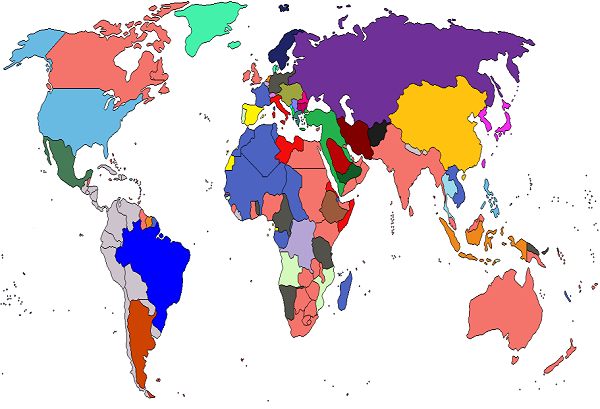
Colonialism is a complex and contentious subject, where historians dispute who or what colonization really benefited. {1-9} Britain certainly could not afford to retain her colonies after WW II, and all colonies (with the partial exception of Chechnya from Russia) regained their independence eventually, though not always easily. The most protracted struggle was in Chechnya, with over 150,000 deaths, and Indochina, which left 58,000 Americans and over a million Vietnamese dead. {10} To the extent that generalizations can be made, the European powers developed colonies to obtain raw materials for their expanding industries, and markets for their manufactured goods. The elements of modern administration, health and education were introduced, but colonies were not allowed to threaten European dominance by industrializing themselves. Colonial boundaries did not always represent ethnic or religious divisions, moreover, which caused dissent when European control was removed on Independence. Many countries, to secure independence in more than name only, sought to industrialize on gaining their freedom, but did not realize what was needed: a disciplined and educated workforce, legal protection of land, investment and innovation, a transparent and equitable taxation system, and markets that were not rigged against them — the USA, Europe and Japan subsidized their farmers and maintained high tariffs on agricultural imports. {11-12}
History
Medieval Europe was largely self-contained until the First Crusade (1096-99), which opened political and commercial communications with the Muslim east. The oriental land and sea routes terminated at ports in the Crimea, Trebizond, Constantinople, Tripoli, Antioch, Beirut and Alexandria (Egypt), and here Italian galleys exchanged European for Asian goods. Competition between Mediterranean nations gradually narrowed to a contest between Venice and Genoa, with Venice winning out when it defeated its rival in 1380. Thereafter, in partnership with Egypt, Venice principally dominated the oriental trade coming via the Indian Ocean and Red Sea to Alexandria. Florentine banks (Bardi in the 14th century and Medici in the 15th century) initially funded this trade, with the Augsburg houses of Fugger and Welser becoming important in the following centuries: they furnished the capital for voyages and New World enterprises. Sea power shifted to the Atlantic nations in the 17th century, from the Mediterranean to the nation-states of Portugal, Spain, the Dutch Republic, France, and England. Maps, navigation and ship building gradually improved, and colonialism by the European nations began around 1500, following discoveries of a sea route around Africa's southern coast (1488) and of America (1492). The Treaty of Tordesillas (1494) partitioned the non-Christian world between Portugal and Spain, and was the basis of Portuguese rule in India, the East Indies, and Brazil. Spain did not immediately follow up Columbus' discoveries, but Hernán Cortés' conquest of the Aztec Empire, and the Pizarro brothers' conquest of the Inca Empire opened up large gold and silver resources, first as plunder and then as mining enterprises using forced native labour. Nearly three centuries of colonial rule followed, the territories being treated as the king's private estate. The Spain crown in fact drew more wealth from taxation than its precious metal mines, but this added wealth did not encourage investment but lavish court spectacle and extravagant wars, which eventually bankrupted the state. From the 17th century, Portugal drew its own supply of jewels and gold from Brazil, but again lost much of its wealth and status as the Dutch, English, and French took an increasing share of the spice and slave trades. {1-5}
For many years, the English West Indies exceeded North America in economic importance, but that was reversed as their populations increased. New England became a region of small farms; the middle Atlantic colonies one of larger-scaled and more diversified farming, and the southern colonies one of slave-based plantations growing tobacco, rice, and indigo. By 1763 several towns had grown into cities, including Boston, New York City, Philadelphia, Baltimore, and Charleston, South Carolina. The loss of the thirteen American colonies spelt the end of the first British Empire, and the start of the USA's growth into a world power. {1-5}
Social amenities in Europe improved as native products and then plantations supplied new crops, materials, foods and beverages — coffee, tobacco, tea, cotton textiles, potatoes, sugar and spices. Institutions also changed as the restrictive trade practices and monopolistic privileges sustaining the slave trade, colonial plantations, and trading companies gave way to industrialisation. The demand shifted from gold, slaves and spices to raw materials for industry (cotton, wool, vegetable oils, jute and dyestuffs) and foodstuffs for the swelling industrial areas (wheat, tea, coffee, cocoa, meat and butter). {1-5}
Colonizing Process
Colonization was instrumental in shaping the modern world, with both its advantages and continuing problems, and brought about wholesale changes to existing communities. Such changes did not impinge on the Chinese, Russian and Ottoman Empires, and had only a limited effect on India, all of which were powerful states, but did transform smaller and unprotected indigenous societies. Before the Industrial Revolution, European activities in the rest of the world were largely confined to: 1. occupying areas that supplied precious metals, slaves, and tropical products; 2. establishing white-settler colonies along the coast of north America; and 3. setting up trading posts and forts, so applying superior military strength to achieve the transfer to European merchants as much of existing world trade as possible. {3} However disruptive these changes may have been in Africa, south America, and the isolated plantation and white-settler colonies, the social systems otherwise remained unchanged. They were self-sufficient small communities, based on subsistence agriculture and home industry, which provided limited markets for the mass-produced goods flowing from the factories of the colonizing powers. Their existing social structures were also unfavourable to commercial agriculture or bulk mineral extraction. {1-5}
The industrializing powers therefore: (1) overhauled existing land and property arrangements, introducing private property in land where it did not previously exist, and expropriating land for white settler use or plantation agriculture; (2) created a work force, either by forced labour or taxation that required wage earning; (3) spread of the use of money and exchange of commodities by imposing money payments for taxes and land rent; (4) closed down competing home industries; and (5) curtailed or prevented export of native products to the mother country. Adding to social upheaval was emigration. Some 55 million Europeans left their native lands in the hundred years after 1820, the result of economic dislocations at home and the attraction of new lands, jobs and social advancement, plus the search for religious and political freedoms. {1-5}
The increasing demands of the Industrial Revolution, for raw materials and market for finished goods, also encouraged colonists to take over large areas of land, either by (1) exterminating indigenous peoples and moving survivors to reservations, or (2) conquering indigenous peoples and transforming their societies to meet the changing requirements of the mother country. So grew a disparity in technologies between the leading European powers and other nations, which only increased with advances in communication, transportation and armaments. Railroads in particular helped consolidate foreign rule over wide areas. With technical superiority came racism and arrogance on the part of the colonizers, an ignorance of viable native customs, particularly Islamic cultures, and much-resented feelings of inferiority among the colonized. {1-5}
The struggle for power and wealth among the European powers was also played out in their colonies and associated military and marine bases. The Portuguese were ousted from their East Indies possessions by the Dutch, who in turn proved too powerful for English companies, which had to content themselves with India. In both India and Canada it was the French who initially held the stronger hand, but their entanglement in European affairs allowed the British to become the dominant power in both continents. Indeed the concept of empire changed. A worldwide trade network, overseas banking, the export of capital to less advanced regions, and the leading position of London's money markets — all under the shield of a powerful navy — led to Great Britain's economic pre-eminence and influence in many parts of the world, even in the absence of political control. Rivalry increased in the late 19th and early 20th century as the number of colonial powers increased, and Africa in particular became a scramble for new territories. {1-5} {13-14}
Egypt
An instructive example is Egypt, which remained largely unchanged until the nineteenth century. The medieval Islamic dynasties came and went, and the Ottoman empire crumbled away, but the peasant societies remained self-supporting, dependent on the annual flooding of the Nile. But once the Suez Canal opened in 1869, and controlled the passage to India, the country became of strategic importance to Britain. Equally important was its potential for cotton, whose supply to English mills had been threatened by the American Civil War. To expand cotton production, the khedive Ismail rapidly developed his country, building railways, canals, telegraphs and extensive docks at Suez and Alexandria. As British banks funded the enterprises, the indebtedness of Egypt steadily mounted, reaching sterling 80 million in 1876. The annual interest alone amounted to sterling 6 million, which had to be extracted from state revenues of sterling 10 million. The peasants were ruthlessly taxed to meet these sums, and in 1875 the khedive was eventually obliged to sell his Suez shares to Britain. 1878 saw a cattle plague and widespread famine. As the machinery of government broke down there was agitation to grant a constitution and more independence from Britain, a situation that endangered banking interests. Britain therefore replaced Ismail by the more compliant Tewfik. Nationalism grew just the same, however, and in 1861 army officers led by Arabi seized control of the government. Britain responded by sending warships to Alexandria, where they employed Bedouin assassins to murder Christians, landed forces to deal with the 'emergency', and defeated Arabi at Tel-e-Kabir. The country was placed under British military control, a 'temporary' measure that lasted 25 years. Under Sir Evelyn Baring, more land was irrigated and brought under cotton cultivation — exports rose from sterling 8 million/year to sterling 30 million/year in 1907. Food had now to be imported. Egyptian society was no longer self-sustaining, and the opposition was such that the country had to be placed under martial law for the duration of W.W.I. A nominal independence was granted in 1919, but the reality of British rule continued through the occupation of the Suez Canal and the Sudan. {15}
The Victorian Bun Penny
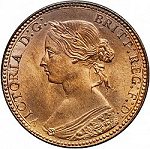 | It was the most pleasing of portraits: bold, sensitive and incisively drawn. The head fills the flan and the bust, decorated with pleasing details of dress, extends to the coin’s edge. The queen is seen in late youth, with a little fullness to the jaw but the mouth set firm and forming part of a forward-looking profile expressive of calm and dignity. |
Britain. Ae one penny. Obverse: Bust of Victoria facing left. Victoria D.G. Britt. Reg. F.D. around. (Victoria By Grace of God Queen of Britain. Defender of the Faith.) 22mm 28 gm. | Victoria was still an attractive woman, a very attractive woman and cognizant of the fact, but also queen and empress. Her hair is done up into a bun behind, the strands sensitively detailed, with the laurel wreath emerging forward from the strands of hair to emphasize the responsibility of office, and the ribbon behind bifurcating, one strand falling behind her head, and the other breaking the wide expanse of the neck and shoulders. |
Above all, this portrait by L.C. Wyon was an extraordinary balance of elements: the bare but subtly-modelled expanse of face and bust, the plain background, the legend and delicacy in the details of hair and dress. Victorian art is often stigmatized as sentimental, prudish and clogged with detail, but here, under the aegis of a continental engraver, is a romantic conception, of a woman expensively dressed but so pleasing in her bodily charms that the personality overwhelms any fussiness in dress or coiffure.
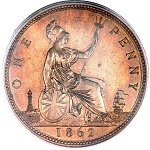 | On the reverse appeared the seated figure of Britannia. Her left hand holds a trident that extends to the coin’s rim. Her right holds a shield. Left and right appears a lighthouse and a ship in full sail, a discreet reference to Britain’s naval power. The legend says simply ONE PENNY and the date, 1862, appears in the exergue below. Once again the design fills the flan, and Britannia, looked at carefully, is a strangely impressively figure. She is feminine, clearly so, but also muscular and elaborately mantled, and wearing a fantastic helmet, the rich plumes of which fell almost to her shoulder. |
Britain. Ae one penny. Reverse: Britannia seated facing right, holding trident and shield. ONE PENNY around. 1862 in exergue. | Victoria's coin image is not an over-delicate portrait, however: the jaw is square-set and a little heavy, almost lumpy. Nor is it entirely faithful: the queen was 43 in 1862, well into middle age. Indeed a contemporary photo shows her so. But it is an appropriate one. It depicts an accessible human being, one that is almost middle-class in an age that was slowly becoming so. |
 The Victorian period is one of bustle, commerce and industry, less concerned with class differences, enjoying more mobility and access to greater commercial products that made everyday life agreeable, often with their raw materials transported across a colonial empire that spanned the globe: the queen eventually ruled one in five of the world's inhabitants.
The Victorian period is one of bustle, commerce and industry, less concerned with class differences, enjoying more mobility and access to greater commercial products that made everyday life agreeable, often with their raw materials transported across a colonial empire that spanned the globe: the queen eventually ruled one in five of the world's inhabitants.
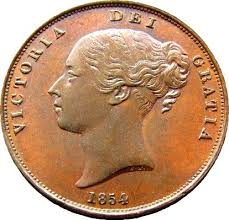 It was not so before. The 1854 penny shows a remote, classical being, the portrait severed at the neck and rather too large for the flan, crowding the legend, which is otherwise attractively balanced between the three words and date. That strong jaw is present, and the sloping profile no doubt emphasizes determination, but the effect is somewhat Germanic: a cleanly chiselled outline that looks taut, forceful and controlled. Words omitted from the obverse legend have to appear on the reverse, which is therefore ornate and somewhat decorative: roses in the exergue rather than the date.
It was not so before. The 1854 penny shows a remote, classical being, the portrait severed at the neck and rather too large for the flan, crowding the legend, which is otherwise attractively balanced between the three words and date. That strong jaw is present, and the sloping profile no doubt emphasizes determination, but the effect is somewhat Germanic: a cleanly chiselled outline that looks taut, forceful and controlled. Words omitted from the obverse legend have to appear on the reverse, which is therefore ornate and somewhat decorative: roses in the exergue rather than the date.
Design in coins serves a purpose: beside the practical utility has to be displayed authenticity, power and legitimacy, words similar in meaning but extending over different fields of human understanding, and generally expressed differently. Authenticity here is assured by the technical competence of the piece: faultlessly machine-struck in good-quality metal. No one would counterfeit such a low denomination, or perhaps could do so. Legitimacy resides in the legend:  Victoria by the grace of God 'queen of England, defender of the faith': titles the kings and queens of England have used since Henry VIII. But power is more indirectly expressed, primarily by the reverse. The Britannia of the 1854 penny is an attractive woman, thickly swathed, no doubt, but with the drapes seeming both light and decently concealing: she seems innocently lost into her costume. In contrast, the 1862 Britannia is a much more assertive figure. The trident reaches to the coin's rim, and the surrounding emptiness of the flan ensures its point is made: Britannia has the attributes of Neptune, the Greek god and ancient ruler of the seas. Nonetheless, she takes her place beside the lighthouse and the sailing vessel, protected by one and protecting the other. But these explanatory references are missing from the 1900 penny. Ship and lighthouse have disappeared, and Britannia is now an imperial power needing no false modesties or fripperies of dress in her statements. The figure, unclothed in arms and legs, grasps the shield firmly, and her manifest destiny is emphasized by the cuirassed bust.
Victoria by the grace of God 'queen of England, defender of the faith': titles the kings and queens of England have used since Henry VIII. But power is more indirectly expressed, primarily by the reverse. The Britannia of the 1854 penny is an attractive woman, thickly swathed, no doubt, but with the drapes seeming both light and decently concealing: she seems innocently lost into her costume. In contrast, the 1862 Britannia is a much more assertive figure. The trident reaches to the coin's rim, and the surrounding emptiness of the flan ensures its point is made: Britannia has the attributes of Neptune, the Greek god and ancient ruler of the seas. Nonetheless, she takes her place beside the lighthouse and the sailing vessel, protected by one and protecting the other. But these explanatory references are missing from the 1900 penny. Ship and lighthouse have disappeared, and Britannia is now an imperial power needing no false modesties or fripperies of dress in her statements. The figure, unclothed in arms and legs, grasps the shield firmly, and her manifest destiny is emphasized by the cuirassed bust.
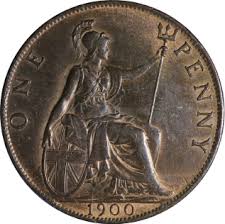 Coins have to be accepted by their users, of course, or, put more crudely, sold. What marketers call the 'inside-out' 'versus the 'outside-in' models — i.e. 'how can we sell what we have' versus 'what do our customers really want' alternate between the three coins. The 1854 coin is a token of classical restraint and gentlemanly manners: you are free to own her while you abide by the laws and customs of the realm: she sells herself to us as something desirable, while not of course appearing to do so. The 1860 is more 'outside-in' in approach: the queen is almost one of us, or how we would like to be. By 1900 the approach has again reversed: she imposes on us as sometimething essential, to emphasize the country's destiny and uphold British values, wealth and supremacy.
Coins have to be accepted by their users, of course, or, put more crudely, sold. What marketers call the 'inside-out' 'versus the 'outside-in' models — i.e. 'how can we sell what we have' versus 'what do our customers really want' alternate between the three coins. The 1854 coin is a token of classical restraint and gentlemanly manners: you are free to own her while you abide by the laws and customs of the realm: she sells herself to us as something desirable, while not of course appearing to do so. The 1860 is more 'outside-in' in approach: the queen is almost one of us, or how we would like to be. By 1900 the approach has again reversed: she imposes on us as sometimething essential, to emphasize the country's destiny and uphold British values, wealth and supremacy.
Imperialism
With later colonialism came imperialism, where the economic benefits were often less than the costs of wars and armaments, and where needed social reforms could be indefinitely postponed. Some historians have seen this as a mixture of patriotism, philanthropy, and the spirit of adventure, driven by the pressure of capital seeking investment outlets beyond the congested and over-competitive situations in the mother countries. Marxists, however, find in it a new phase of capitalism, monopoly capitalism, where tacit alliances between large industrial and banking firms allow for cooperation rather than wasteful competition. The accompanying need to obtain an exclusive control over raw material sources and a tighter grip on foreign markets encouraged rivalry for colonial possessions by the big powers, and therefore empire building. {24}
Joseph Schumpeter reached similar conclusions from another perspective. Surveying empires from earliest times, Schumpeter identified three factors. First was a persistent drive towards wars and conquests that served no rational, utilitarian aim. These drives were, secondly, not innate but evolved as peoples and classes took up arms to avoid extinction, and continued long after their warrior mentality was really needed. Thirdly, the drive to war and conquest served the domestic interests of ruling classes, often under the charismatic leadership of individuals who had the most to gain. Without these factors, Schumpeter believed, imperialism would have been swept away long ago since capitalism thrives best under peace and free trade. With monopoly capitalism, however, the fusion of big banks and cartels creates a powerful pressure group that sought higher profits from what they could control more easily. But where Marxists see empire building as a natural consequence of capitalism, Schumpeter saw it as an artificial graft. Monopoly capitalism requires protection behind high tariff walls — without which there can be large industries but not cartels or monopolies — and those tariffs are set by the state, which is therefore a fusion of the previous autocratic state, the old war machine, previous feudal interests and ideas, and capitalist interests. Imperialism is still much debated, but most historians accept some variant of Schumpeter's thesis, though the same model will not fit all situations. {24} Religion, imposed or rekindled, played a part in many imperial ventures. {25}
Marxist thinkers stress the individual social contexts that today cause inequality, unemployment, and environmental degradation. General economic categories such as 'finance', 'manufacturing', 'banking' and 'services' are historically disembodied entities unless both the political economies and the source of financial wealth are properly understood, some of which are legal, and others less so: the drug trade, money laundering, real estate speculation, etc. International finance has superseded imperialism, though military force (declared or covert) has sometimes been resorted to. {26}
Africa
Looked at more carefully, with the British African colonies as an example, it is sometimes helpful to distinguish four phases of colonialism. In the first, which lasted to the 1930s, the colonies were run for the benefit of the mother country, supplying raw materials for home industries and providing a market for its manufactures. Suppression of the slave trade, and the search for substitutes had led Britain, for example, to acquire Sierra Leone in 1808, Gambia in 1816 and the Gold Coast in 1821. To handle the foreign trade on which colonial prosperity depended, expatriate banks were set up — generally branches of banks in the mother countries, which were hived off as independent entities once justified by the volume of business. The mother country also provided the colonial currency, which often had to be 'cash', i.e. silver coins or even native money. In the second phase, which lasted to Independence, the preference was reversed, i.e. the countries were more run for their individual benefit and not necessarily that of the mother country. Agriculture and local manufacturing was still orientated towards export, often to the mother country and encouraged by emigration, {11} but rudimentary institutions and facilities were developed that the colonial country would need on achieving Independence. In the third phase, which lasted from Independence to the quadrupling of oil prices in October 1973, the newly independent countries embraced central planning and Keynesian economics and indeed made, most of them, considerable economic progress, though often lapsing into one-party states. All that came to an end in the fourth phase, after the oil price hike, when increased energy costs and the trade slowdown required them to borrow heavily: they rapidly became indebted to western banks and then to Neoliberal policies, which have kept many of them poor. {27-28}
Other commentators view African colonialism in a less kindly light, noting that the USA and European powers became more aggressive during the 1873-93 'Long Depression', no longer content to respect local rulers and Ottoman oversight, but intervening directly in African affairs to grow commodities and extract raw materials. {29}
Modern Europe
Contrarian commentators regard the economic and financial pressures that the big corporations and banks exert on smaller countries as colonialism in all but name. Wealth is transferred by 'soft power' to western interests. The Greek debt deal, for example, benefits not the Greek people or its institutions, but financial interests — the European Commission, European Central Bank, IMF, and European Stability Mechanism — that will acquire Greek assets at fire-sale prices. US and EU bankers were installed in December 2014 in Ukraine as Ministers of Finance and Economics. Debt in that now bankrupt country rose from $12 billion in 2007 to $100 billion in 2015. Wealth will be extracted by interest payments and privatisations. Some 342 former government enterprise companies are slated for sale in 2015, including power plants, mines, 13 ports, and farms. {30}
Another case is Syria. Economic sanctions by the EU, the Arab League, Turkey, Canada and Australia — and most particularly the USA from the 1990s — sought to weaken Syria’s support of Hezbollah and the Palestinian resistance groups. Access to certain goods and banking services were restricted, which led to shortages in essential items, including medical supplies and agricultural equipment. Combined with a severe drought, and a repressive government, the result was the 2011 outbreak of violence, which the west fanned by supporting dissident groups with money, training and weapons. {31}
Other Countries
But not all new states are poor. Singapore's 5.4 million are wealthier in GDP per capita terms than the citizens of the United States or Germany. Helped by an authoritarian government, an open pro-business economy, excellent education, a strong work ethic and quality public housing, the GDP per capita rose from $4,756 in 1980 to an estimated $52,179 in 2013. {32} Chile is another success story, benefiting from pension reform, privatisation, honest government and low taxes, though with widening inequality. {33} Nigeria, by contrast, is not a success: ethnic divisions, inept military governments, endemic corruption and now religious strife have more than counterbalanced its enormous oil wealth. {34} Each country is different, with its own set of advantages, customs and problems. {35-36}
References and Further Reading
Need the 36 references and 5 illustration sources? Please consider the inexpensive ebook.
